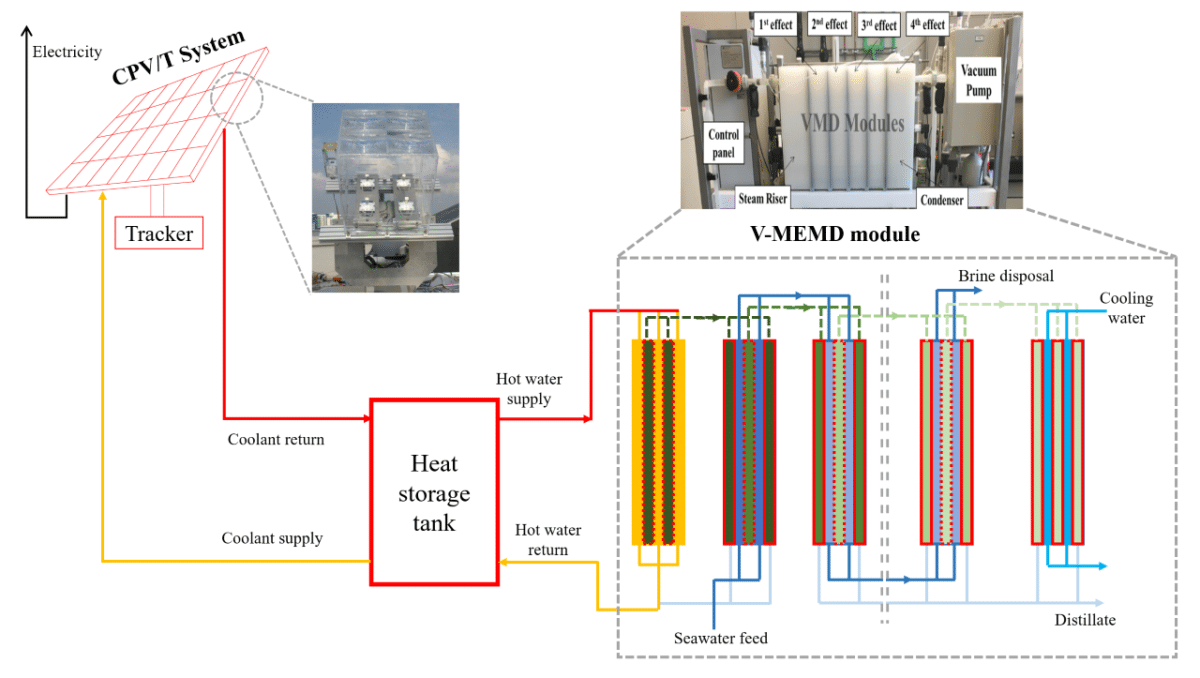Researchers from the King Abdullah University of Science and Technology (KAUST) in Saudi Arabia and the Donghua University in China have designed a decentralized cogeneration solution for the production of power and freshwater that combines concentrated photovoltaics and solar thermal collectors with a vacuum multi-effect membrane distillation (VMEMD) system. It is based on a thermal separation process with microporous hydrophobic membranes and can reportedly concentrate liquids with high salt concentrations close to saturation.
“The system was so far developed at the laboratory level,” KAUST researcher Qian Chen told pv magazine. “We have completed the study on CPVT and the VMEMD modules and now are working on system integration.”
The proposed system was assembled with several concentrated photovoltaic/thermal (CPV-T) collectors, a hot water tank, a V-MEMD module, a seawater feed tank, and a distillate tank.
The electricity produced by the CPV-T installation is supplied to potential final users while the generated heat is used to produce hot water to power the V-MEMD system. In the latter, the seawater supplied from the feed tank partially evaporates, and the produced vapor is then condensed. In the following step, the condensation heat is reused to heat the seawater and further induce evaporation. “The process is repeated several times in the subsequent effects, and vapor produced in the last effect is condensed in an external condenser,” the researchers explained, adding that polytetrafluoroethylene (PTFE) membranes are utilized at the evaporation interface to separate water and vapor. The water is then stored in the distillate tank.
The CPV-T system is comprised of Fresnel lenses, glass homogenizers, triple-junction solar cells based on indium gallium phosphide (InGaP), indium gallium arsenide (InGaAs) and germanium (Ge), a heat sink for cooling, and a two-axis solar tracker. “The solar cells convert a portion of the solar radiation into electricity, while the remaining radiation is dissipated as heat,” the academics said. “Coolant is circulated below the cells to absorb the generated heat, which not only lowers the cell temperature and improves the cell efficiency but also recovers the heat for desalination application.”
The solar system showed a power conversion efficiency of 25% and a thermal efficiency of 45% during an entire year. “The energy efficiency of the system is dominated by electricity generation, and its value is stabilized at 25-27% under different design and operating conditions,” Chen told pv magazine. “The levelized cost for desalinated water is $0.7-4.3/m3, depending on PV cost and electricity price.”
The system is described in the paper A decentralized water/electricity cogeneration system integrating concentrated photovoltaic/thermal collectors and vacuum multi-effect membrane distillation, published in Energy.
This content is protected by copyright and may not be reused. If you want to cooperate with us and would like to reuse some of our content, please contact: editors@pv-magazine.com.




By submitting this form you agree to pv magazine using your data for the purposes of publishing your comment.
Your personal data will only be disclosed or otherwise transmitted to third parties for the purposes of spam filtering or if this is necessary for technical maintenance of the website. Any other transfer to third parties will not take place unless this is justified on the basis of applicable data protection regulations or if pv magazine is legally obliged to do so.
You may revoke this consent at any time with effect for the future, in which case your personal data will be deleted immediately. Otherwise, your data will be deleted if pv magazine has processed your request or the purpose of data storage is fulfilled.
Further information on data privacy can be found in our Data Protection Policy.